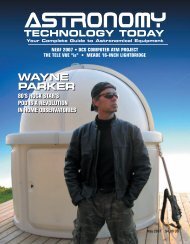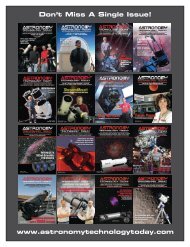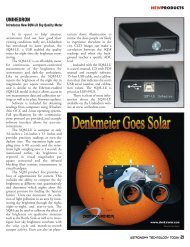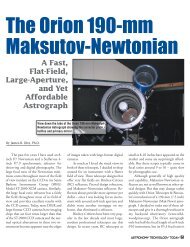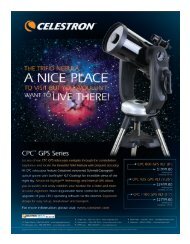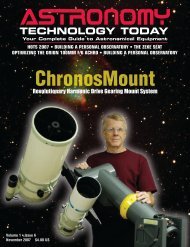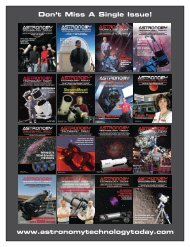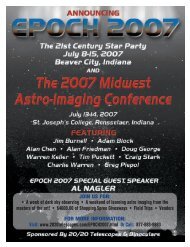iOPTRON - Astronomy Technology Today
iOPTRON - Astronomy Technology Today
iOPTRON - Astronomy Technology Today
You also want an ePaper? Increase the reach of your titles
YUMPU automatically turns print PDFs into web optimized ePapers that Google loves.
M-UNO: A PIER-LESS MOUNT<br />
ing run to perform a meridian flip was<br />
worth the price of admission.<br />
Next, Luciano suggested I slew the<br />
mount to NGC 2903, a beautiful spiral<br />
galaxy in Leo. Once again, the go-to was<br />
spot-on, and the hunt for a guide star was<br />
as smooth as could be. Starting at shortly<br />
before 11 p.m. local time, I proceeded to<br />
take one image each of 10-, 15-, 20- and<br />
30-minute durations as the object approached<br />
the meridian.<br />
The 30-minute integration included<br />
here shows the lower left portion of the<br />
frame enlarged to 400 percent to demonstrate<br />
the M-Uno’s tracking accuracy.<br />
Blooms from my NABG camera aside, the<br />
stars are round and tight. The mount carried<br />
the imaging train across the meridian<br />
without a pier flip and without any discernable<br />
impact on tracking. (I think the<br />
longest integration I took with my own<br />
mount was 10 minutes.) The M-Uno produced<br />
round stars after thirty minutes integration.<br />
To me, that’s phenomenal.<br />
Luciano wanted to capture an image<br />
of Arp 244 in Corvus, the Antennae Galaxies.<br />
I have imaged this object before, but<br />
with only mediocre results. Off we went,<br />
with the M-Uno slewing smoothly and<br />
quietly, and placing the object right on target.<br />
Even though it’s tough to capture<br />
much detail with a 7-inch telescope, a 10-<br />
minute integration captured the object’s<br />
faint filaments. The go-to was, once again,<br />
spot on, and M-Uno’s precise tracking produced<br />
nice round stars.<br />
The coup de grce was the next object,<br />
the Leo Triplet (M65, M66 and NGC<br />
3628). I took a break to allow the objects to<br />
get close to the meridian so that I could see<br />
how well the M-Uno tracked across it.<br />
Imagine that — delaying the imaging run<br />
to let the objects cross the meridian. That<br />
would be almost unheard of with a GEM.<br />
The Intes scope has a wide enough<br />
field of view that I was able to position all<br />
three objects on my camera’s chip, acquire<br />
an adequate guide star, and track across the<br />
meridian without interruption. I began a<br />
LRGB imaging run at 12:55 a.m. local<br />
Image 8 - The Leo Triplet (LRGB).<br />
time. As the objects crossed the meridian,<br />
I continued the imaging run without disturbing<br />
the OTA. In processing the image,<br />
I was very impressed with the amount of<br />
detail in the galaxies that the M-Uno enabled<br />
the 7-inch scope to obtain. In addition,<br />
the M-Uno’s accurate tracking<br />
produced round stars in every sub-frame.<br />
There were no wasted frames due to faulty<br />
tracking, in contrast to the other imaging<br />
runs I did with my own GEM.<br />
Luciano and Givoanni generously<br />
loaned the M-Uno to me for additional<br />
evaluation. The mount and tripod pack<br />
into two durable soft cases for easy transportation.<br />
I decided to test M-Uno’s upper<br />
payload limits by putting my f/10 C-11<br />
Get Yours<br />
<strong>Today</strong>!<br />
and camera on it. I was very excited to see<br />
if the M-Uno would perform as well with<br />
a heavy payload as it did with the smaller<br />
telescope, and at a higher latitude.<br />
Prior to leaving WSP, Luciano installed<br />
the latest version of StarGo on my laptop.<br />
Configuring the program to communicate<br />
with the M-Uno through the USB interface<br />
was quick and intuitive. Installation of<br />
the driver is necessary to interface with the<br />
mount using a planetarium program<br />
and/or POTH.<br />
In order to explore the M-Uno’s Bluetooth<br />
interface, I was forced to violate my<br />
open-source software rule. I purchased Sky<br />
Safari Plus for my Android smartphone to<br />
run the M-Uno via Bluetooth. Sky Safari is<br />
Let us custom build you<br />
the best, strongest, most<br />
well constructed scope<br />
transport case available!<br />
www.scopeguard.com<br />
<strong>Astronomy</strong> TECHNOLOGY TODAY 49



